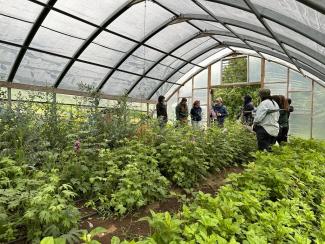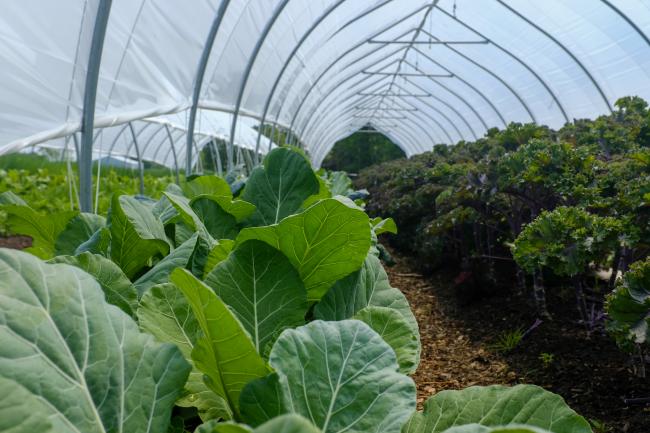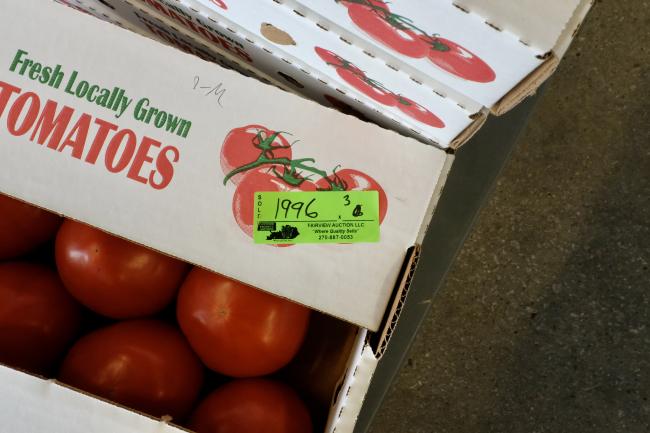Choosing High Tunnel Crops: Revenue Basics
I recently helped lead a professional development workshop for NRCS and Extension personnel about how to use the new High Tunnel Resource Guide for Producers. Part of the workshop was about crop selection for high tunnels. There are lots of different variables for choosing a crop, but my focus was on the economic factors.
Our standard recommendation is always to to add up your specific costs (including labor) and compare those to your potential revenue from your specific markets (including the price and potential sales volume) to truly evaluate the crop. Our enterprise budgets are a great tool for starting the research to calculate those numbers. There are also budgets in the Resource Guide.
But if you’re just kicking around crops what should you think about? Are certain types of crops a better fit than others? As I often do with these questions, I approached it like I was going to do it myself. So I picked a few crops and did some math you can see below. NOTE: This is not a peer reviewed extension publication (though we may think about making one of those) and these are just very rough “back of the envelope” estimates to get you thinking. You might quibble with some of my numbers—maybe your price is much lower or higher at your market, or maybe the densities are way off base for you. That’s great—plug in your numbers and do the same math. I think you’ll find the general trends still apply, but always rely on your own numbers if you have them.
For the calculations below, I assume:
- One 30 foot wide x 72 foot long tunnel
- Filling the tunnel with just one crop (as opposed to multiple different crops at the same time in one tunnel)
- Moderate to high planting densities
- Moderate to high yields
- Direct to Consumer prices based on CCD Farmers Market Average Prices
- I can sell 100% of what I grow at that price
- We are calculating pre-cost revenue ONLY here. Labor and other costs will vary considerably.
Tomatoes, hybrid (75 days to harvest from transplant)
150 plants x 10 pounds per plant x $3 per pound = $4500 revenue
Watermelon (80-90 days to harvest)
75 plants x 3 harvestable melons per plant x $8 per melon = $1800 revenue
Sweet Corn (60-90 days to harvest) = $1500
1200 plants x average 1.5 ears per plant x $10 per dozen = $1500 revenue
Lettuce (35 days to harvest from transplant)
720 heads x $5 per head = $3600
BUT…in one crop cycle of tomatoes we can actually harvest 2 plantings of lettuce so in 75 days, we could expect:
720 heads x $5 per head = $3600 x 2 plantings/harvests = $7200
If you think this article says “Brett told me to grow lettuce in my high tunnel” then go back and read the first section. These are ballpark estimates to help you start narrowing down crop types. These are also just potential revenues. Tomatoes take a lot of labor, lettuce may require some upgrades to your post harvest handling. Each of these decisions will be made case-by-case. But can we learn anything useful about crop selection from these numbers?
Space in your tunnel is at a premium. Growing in a high tunnel costs considerably more per square foot than growing in the field,
- Avoid plants that spread and sprawl (watermelons, broccoli, squash, etc.) as they take up a lot of space for less output. Crops that can be trellised or remain small are optimal.
- Access to the tunnel for spraying, scouting, repairing irrigation etc. in a tunnel jam-packed with watermelons would also be problematic
To quote Dr. Rachel Rudolph (with whom I presented this content) “a lot of stuff grows great outside.” Only grow in a high tunnel if you have a good reason.
- Offering products early or late (season extension) is one major reason people choose to grow in tunnels. Have you pushed the limits of seasonality? Do your markets pay more for early or late product?
- Quality and disease management is another reason for growing in tunnels. Things with high crop losses in wet conditions (peppers, tomatoes, etc.) may be worthwhile to protect, especially if the higher quality means customers will pay more.
Some higher value crops command premiums (tomatoes, lettuce, cut flowers) and you should be producing premium-generating items in your tunnel to maximize its economic impact.
- CCD price reports are one good place to identify potential prices in your market.
- Talking with vendors and businesses in your area can also help you understand the premium-demanding products.
Verify your markets, prices, and volumes—especially if they are early or late in the season.
- Verify that a market exists for your product and for the time of year you are intending to produce it.
- Some of our Farmers Markets have strong off-season customer bases. Many do not—make sure this is the case before you make the leap.
- If your plan for off-season sales is to “sell to restaurants and schools” know that that will likely come with lower prices and potentially more costs for food safety certification. Your local extension agent can help you get connected with people and resources to explore that. You might also check out the MarketReady program.
- This verification includes assessing how much product you can sell through those channels. In some markets 720 heads of lettuce is an average morning, in others it’s more than you’d sell in a month or longer.


